Your daily dose of Product Management Goodness
Want to know more?
We would love to hear your questions and suggestions for topics you would like to see covered in our future blog posts, so don't be shy and get in touch!


Product Thinking Fundamentals
No.2
Strong Vision gives us Direction.
If Product Managers had a magic wand they would use it to predict future trends!
Unfortunately we don’t, so, having a strong vision is one of the keys to product/service success.
Miss the trend and your product or service becomes irrelevant.
Think about the introduction of internet.
When it first arrived, we could not have predicted the scale of change this would bring about. Companies collapsed when customers embraced the convenience of having everything at their fingertips. One of the casualties of this trend was Blockbuster.
More recently, during the Pandemic, the internet has thrived. Some businesses have recognized the tidal wave and ridden it. Technology has enabled us to work from home, it has provided comfort for loved ones and provided the tools for us to socialize virtually. It’s helped us get all our essential shopping with the touch of a button and, kept us entertained daily through social media.
Amazon, Google, Zoom, Teams and Boohoo amongst others, have all surfed the crest of the wave, others have floundered and become irrelevant.
read more

Product Thinking Fundamentals
Product Thinking Fundamentals.
No.1
Great strategy is built on great research.
Data really is everywhere, and product teams need to understand their customers, competition and markets. We use multiple data sources, and it’s never won and done. Product Thinkers ask themselves every week what have I learnt about my customers, my markets, or my competition. We know that truly understanding our customer wants and needs requires much more than desk-bound research.
Ask yourself how can you spend more time with your customers.
read more

Product Thinking Fundamentals
What is Product Thinking?
Product team work to understand how our products and services can be continuously improved to solve customer pain, they then work in an agile way to create customer value as quickly as possible.
I would say most of us make a ‘product’ or deliver a ‘service’, and that we all need to understand our customers and create value for them. So, Product thinking can be a useful practice in every department, by approaching the work you do as a product with specific customers, giving your teams problems to solve and measuring your success you’ll deliver customer value more quickly.
During the course of this week, I will be focusing on 5 product thinking fundamentals.
read more
Key Characteristics of a Good PM
It’s a question we face all the time. Mostly, when we’re helping businesses build a product management function. When recruiting experienced Product Managers, you might look for certain skills; launch skills, research skills, pricing skills, etc.
Why not look internally for those who are looking for a new challenge? They might not have the experience or skill set just yet, but do they have the core capability?
Try our quick checklist for working out if they have PM potential:
Curiosity – Do they demonstrate intellectual interest? Are they eager to learn?
Drive – Do they show ambition?
Discipline – Are they organised?
People skills – Can they get people to listen to them. Can they take people with them? Are they charismatic?
Communication – Can they get their point across clearly and quickly?
Thought leadership – Do they have vision? Are they a creative problem solver?
read more
Capability Scores
When is a good opportunity NOT a good opportunity?
When it doesn’t match capability. It’s easy for Product Managers to get carried away with an idea and forget to look into their business. That knock-out opportunity you’ve identified might simply not match your organisation. Think of it as a capability review. Does your business have the funds, technical skills, market access, reputation, reach, scale and strategy intent to address the opportunity. If not, that great new product idea has the potential to sink your business.
read more
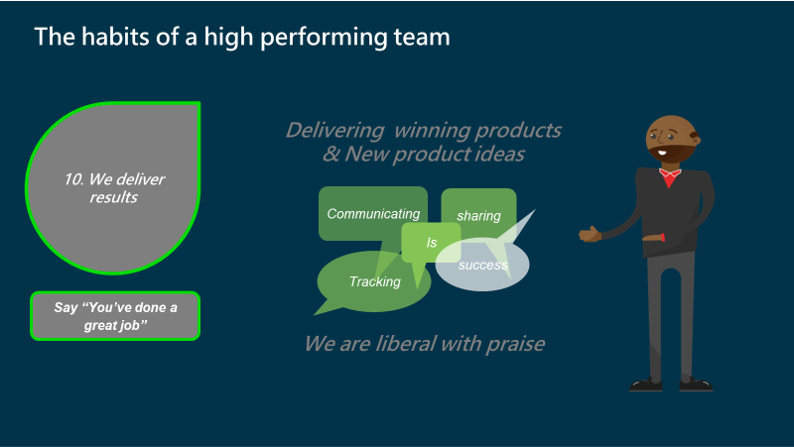
Habits of a High Performing Team
Habit no 10
We Deliver Results.
Listen and communicate constructively and effectively. Encourage the sharing of opinions and learn by mistakes and mishaps.
Track success through metrics
Commit to improving your skills.
read more

Habits of a High Performing Team
No 9. We are not afraid to fail.
Lean upon the process of product management to 'Fail Fast'. Iterating fast failing achieves a desired result faster than perfecting the solution.
In the complex digital revolution era, trying to predict, control, and eliminate variances is a losing game. Reducing variance inevitably meets the law of diminishing marginal returns. The cost of reducing variance eventually exceeds the benefit.
In addition, the goal of controlling and minimising variance can be deceptive because we don't know what to measure in a complex environment that changes so rapidly. We can't control what we cant measure. The minute we figure it out, what we need to measure has changed.
read more

Habits of a High Performing Team
Habit No. 8
We Play to Team Strengths.
One way to ensure your team is motivated, engaged, and performing to the best of their ability is to play to their strengths.
If you are interested in determining the strength of a team, use one of the many online questionnaires that are designed to understand individual and/or team strengths. These assessments focus around a list of 30 or so potential strengths, and, after taking the assessment, highlights about 5 top strengths, resulting in you gaining a clearer insight as to where your team members natural talents lie.
read more

Habits of a High Performing Team
Habits of a High Performing Team
No 7
We Feedback Continuously
Clear communication enables the team to deliver a high quality of work.
Emphasis should be placed upon identifying barriers and achievements to past performance to inform future performance.
Find insights and make changes that focus upon the critical elements that will actually drive performance.
Regular structured feedback creates a shared responsibility for performance:
Employees or individuals own their performance.
Managers empower, enable and facilitate it.
read more

Habits of a High Performing Team
NO 6
We Value Difference.
Do we ask enough questions, or are we happily settling for what we already know?
Avoid managerial biases and embrace the fact your team will work and act in different ways.
e.g Do you do your best work early in the morning, or do you get your most productive second wind late at night?
Timing, especially with flex workers, does matter to some managers.
According to a new study, researchers at the University of Washington Foster School of Business found that people who elect to work an early shift are perceived by their bosses to be better employees than those who work a late shift.
read more

Habits of a High Performing Team
NO.5
We continuously learn.
' Your ability to learn or the quality of your learning as an individual or an organisation will be the primary factor in your ability to stay relevant and competitive' (Edward Hess).
Set goals, make small but consistent improvements towards those goals and objectives and commit to them. Once you achieve consistency, confidence will blossom.
Ask for feedback
This changes your perspective and you get new ideas.
Prepare for the unexpected. You must be able to anticipate barriers and respond quickly to problems.
Boost your profile.
Individuals obtain 70% of their knowledge from job related experiences, 20% through interactions with others and 10% from formal training.
read more

Habits of a High Performing Team
NO.4
Excellence isn’t micromanagement
Excellence is a consistently high standard of performance employees may not always attain, but even when they don't their effort is excellent.
Excellence is reflected in 2 ways:
Formal goals and Informal expectations.
Formal goals that are aggressive but not so high they're impossible to reach, which only serves to demoralize.
Informal expectations are the casual attitudes we display on an everyday basis: that all work we receive will be high quality, done with care, and to a person's very best ability.
read more
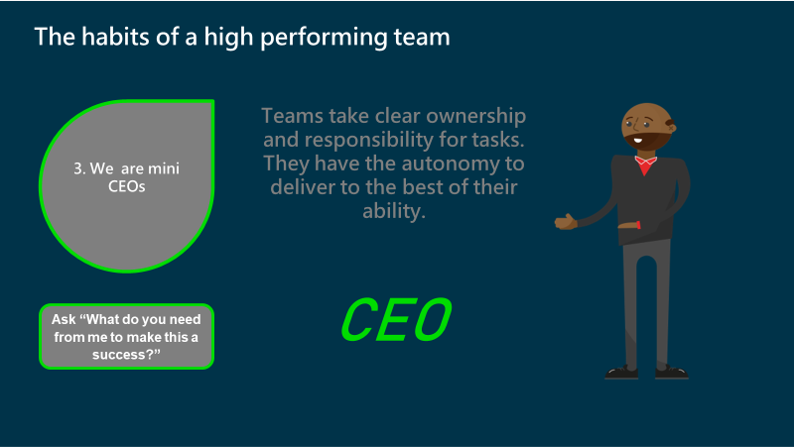
Habits of a high performing Team
Habit No.3
There is a lot of debate about Product Managers being CEO's of their product. In today's workplace, the CEO mindset is exactly what we need, not just for Product Managers, but also the entire team... Individuals capable of making their own decisions and possess the ability to get the work done.
Determine which CEO skills your product need now and
create a strategy to achieve that.
Develop a right culture, a 'way of being' in your team that brings out the best in people and supports them to feel autonomous.
read more

Habits of a High Performing Team
Habits of a high performing team
No 2
We set ambitious objectives.
Goals are full of unlimited potential and if we fail to set ambitious goals for ourselves we fail to reach our full potential.
So, low goals produce sub-par results and ambitious goals lead to improved results.
Naturally, we are not always able to achieve all of our 'high' set goals, however the act of trying moves you far closer than if you had set them at average level.
- Set the bar high.. Reach for the stars!
- Make a plan. Every goal needs a plan..
- Create short term milestones..
- Assess your achievements.. celebrate them.
Never stop learning
read more
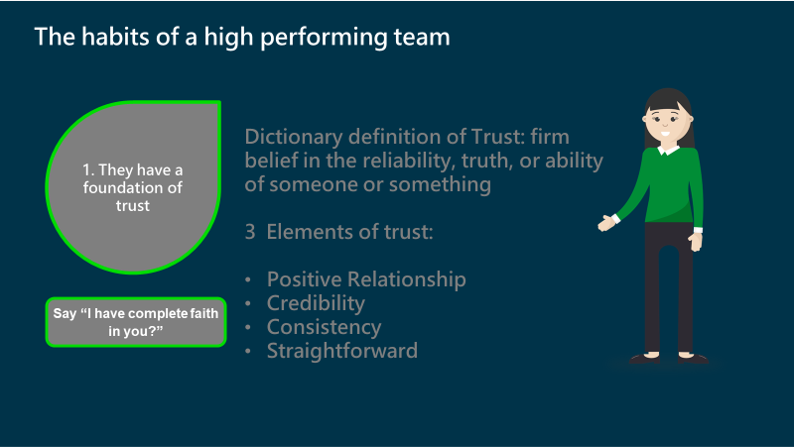
A High Performing Team
HABITS OF A HIGH PERFORMING TEAM
NO.1 Have a foundation of trust.
Create POSITIVE RELATIONSHIPS by Staying in touch on the issues and concerns of others. Give honest feedback, resolve conflict whilst balancing concerns for others and generate co-operation to achieve a resolution.
Use GOOD JUDGEMENT when making decisions. Anticipate and respond quickly to problems using a solid foundation of knowledge and expertise to achieve results. Others will trust and seek your opinions.
Be CONSISTENT.
Be a Role Model.
Walk the talk and follow through on commitments.
Go above and beyond what needs to be done.
read more
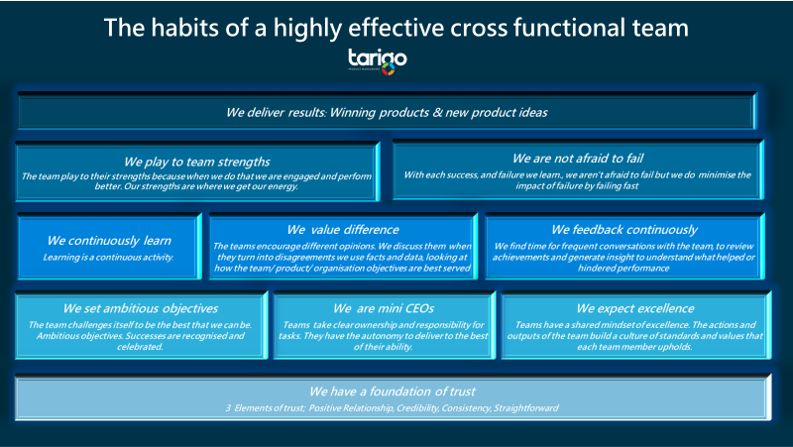
10 Habits
Over the next few days I will be showing you the 10 habits of a highly effective cross functional team.
Here is a brief look at what's to come.
read more
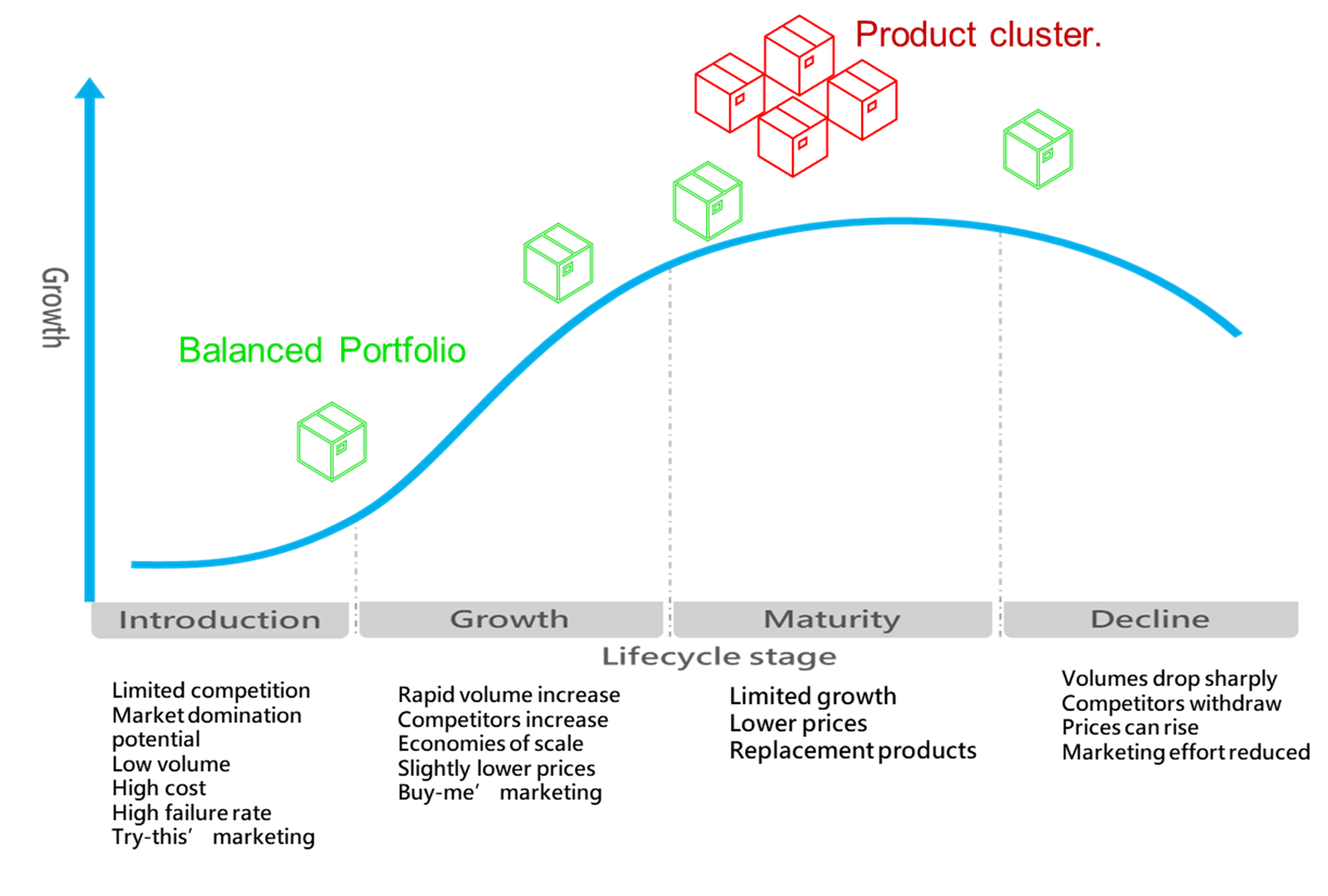
How Balanced is your Portfolio
How balanced is your portfolio? Unbalanced portfolios cluster around lifecycle stages. magnifying lifecycle-stage risk. (For example, all products tracking into decline at the same time). Balanced portfolios spread across the lifecycle stages
read more
Big VS Small Business PM
Big Business vs Small Business Product Management
We train product management in some of the biggest and smallest companies globally.
Last year our biggest client employed over 4,000 people in product roles and our smallest had a product management team of one. Clearly there is going to be some change to the PM role depending on the size of the business and the product team, so what is the difference?
What does product management look like at these extremes? I’d characterise it like this – GLUING VS DOING.
In a big team, the product manager has marketers, pricing experts, launch managers, research teams, etc. Their job is to use those extensive resources to build out the perfect product. They GLUE.
In a small team, the product manager doesn’t have the same extensive team and resources available, therefore they need to figure out most of the detail for themselves. They DO.
The core discipline remains the same but the daily actions can look very different. When we train teams we pay attention to this because we are aware of the differences – it’s one of the ways we can be effective in very big and very small teams.
read more
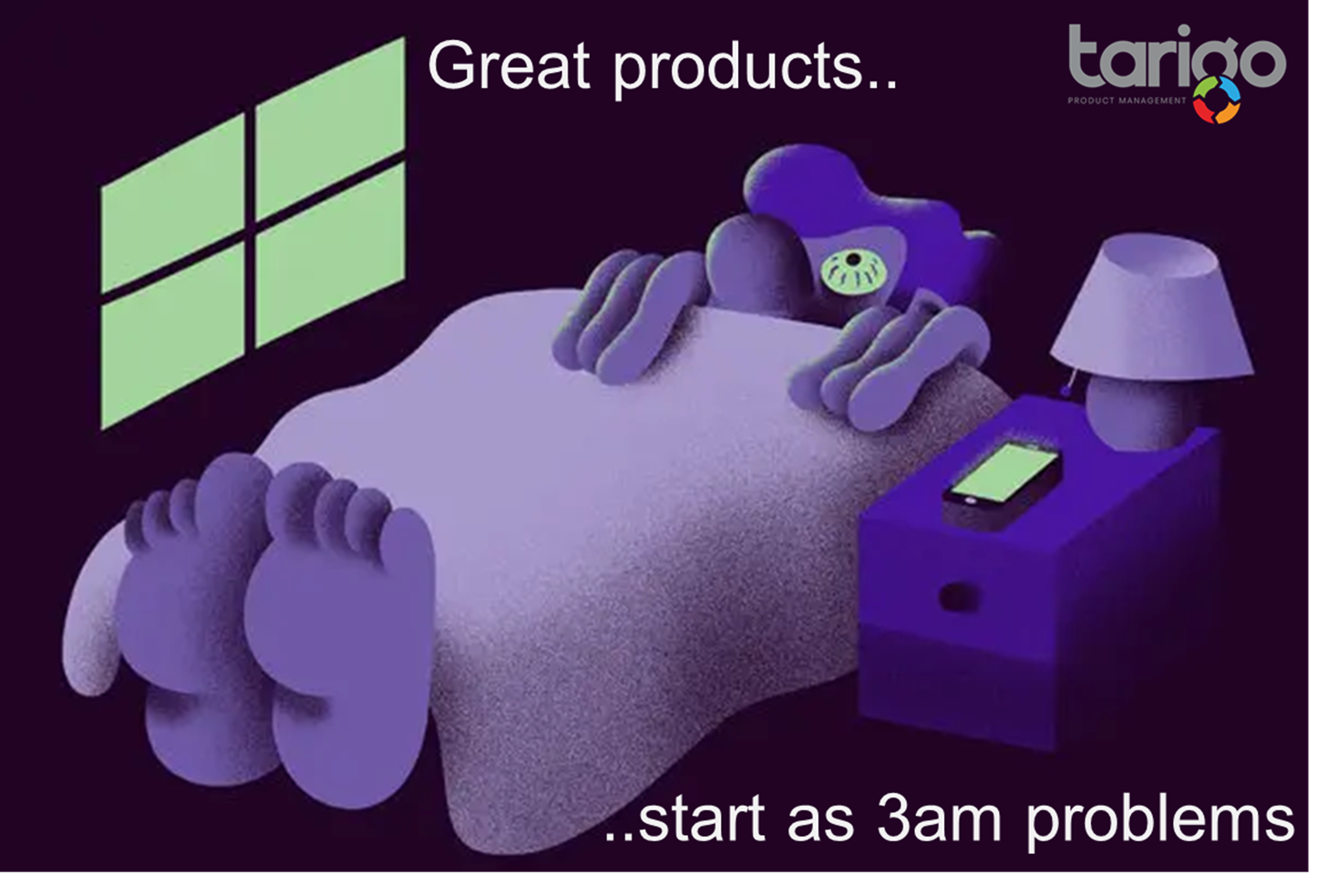
3A.M Problems
Find the 3 A.M. problem
We work with many teams who want to innovate more – find the next big thing that will propel their business forward. Often these conversations focus on the product “What new shiny thing can we take to market?”. This is not the right place to start. In the B2B world, great products are built on solving real world problems. The bigger the problem, the more motivation there is to fix it. Obvious really, but missed by so many teams on their quest to uncover a winning idea. So, next time you’re looking to innovate, start with this question “What problems are keeping our customers awake at night?”. Problems that wake someone at 3am, are problems they’re motivated to solve
read more

Churn Or Retention
Ever tried to fill a sink with the plug out? Thought not. Trying to grow a business with a high churn rate is similar – every good thing you do to grow with new product and service is negated by customers leaving (or more recently, a pandemic)
Something every product manager should sweat about are their churn or retention stats. Here are two things to do to reduce churn:
1. Know your customer behaviour and lifecycle
Customers who churn typically show pre-churn behaviour (lack of use, complaints, etc) or are date driven (contract renewal). Work out the signs and timing and build intervention strategies
2. Make your product frictionless
The more barriers you put in the way of usage, the lower the usage (and therefore retention). Something as simple as a complex login process can kill a product. Think of amazon one click as properly frictionless and try to away the barriers to using your product.
Hard work I know, but think about the results – a two percent reduction in churn equates to more than a 10% revenue increase over a 5 year window. It’s worth the effort
read more

Market Shift
Does your Market Disappear or Shift?
The ‘decline of the high-street’ has been regular news for the what seems like forever. Few weeks go by without another casualty hitting the headlines.
Take Blockbuster for example, they filed for bankruptcy, blaming a declining market. In reality, their market was larger than ever, it had just shifted towards the online & digital space.
So, what can we learn from this? Sure, some markets disappear, but most shift. And these shifts cause disruption that product managers can either embrace and take advantage of or ignore and find their products and services irrelevant.
Don’t get left behind by your market because of stubbornness or short-sighted, tactical thinking.
read more

PM Health Check
It looks like Spring is on its way, so it's time for a PM health check!
How do you review the maturity of a PM function? We use a 360 review:
• People
Without the right team in place it’s impossible to excel. We review the team through capability (Do they have the potential to be a great PM?), skills (Do they have the right PM experience?) and scale (Is there enough of them?)
• Processes
We review the full process, reporting, RACI, etc, viewing the process in terms of fit to your business (Risk vs reward vs scale vs speed vs certainty vs evidence vs innovation)
• Tools.
Without standardisation, product managers use such a wide variety of tools that it becomes increasingly difficult for a management team to make reasoned decisions – they cannot do an ‘apples to apples’ comparison. We review the complete process suite for robustness, ease of use, visibility and adherence.
• Environment
A great PM team, with the right processes, tools and templates can still fail to thrive because of the environment - stakeholders, supporting processes and management not aligning with product. We review stakeholder teams leadership engagement and adjacent processes to asses alignment.
read more
Check out the Archive